Films by Janie Geiser

Image from Lost Motion, by Janie Geiser
By Fred Camper
This review of films by Janie Geiser is also available on the Chicago Reader Web site, in the form that it appeared in the print version of the newspaper, in the issue of May 26, 2000. I have made a few additions of links, and have found a few minor adjustments that needed to be made in the text after the review appeared in print, so I have taken advantage of the Internet to place the new version on my own Web site here. Fred Camper

Image from Lost Motion, by Janie Geiser
By Fred Camper
Janie Geiser’s exquisite short films are often inspired by doll-like figurines, typically decades old. But though she animates these figures and cutouts and other objects in her cryptic narratives, her work goes well beyond childish make-believe, as her four films (included in her program May 26 at Chicago Filmmakers demonstrate. Complex, full of charm, and pervaded by themes of failure and loss, her art simultaneously creates and deconstructs illusions.
Key images in The
Red Book{1994) acknowledge the artist’s constructions: as a woman’s
hands move back and forth, pages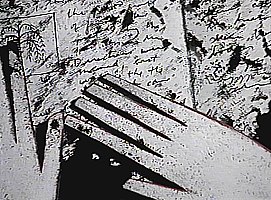
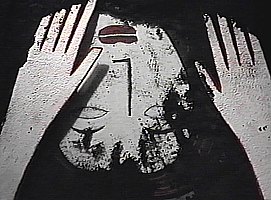 of
handwriting and drawings and later a woman’s face appear beneath her fingers.
But in fact many moments in Geiser’s films undermine her illusions. Unlike
Hollywood animated characters, her tiny figures move jerkily, never fooling
one into accepting them as living beings; her figures are either visibly
hinged or solid objects, and their facial expressions never change. She
never tries to conceal the miniature scale of her work: a “forest” is an
assemblage of small plants, for instance. And her key cinematic devices
— superimposition and moving light patterns — are blatantly artificial.
of
handwriting and drawings and later a woman’s face appear beneath her fingers.
But in fact many moments in Geiser’s films undermine her illusions. Unlike
Hollywood animated characters, her tiny figures move jerkily, never fooling
one into accepting them as living beings; her figures are either visibly
hinged or solid objects, and their facial expressions never change. She
never tries to conceal the miniature scale of her work: a “forest” is an
assemblage of small plants, for instance. And her key cinematic devices
— superimposition and moving light patterns — are blatantly artificial.
Geiser is still best known for her work in puppetry. (Her ensemble, Janie Geiser & Co., will perform June 1-4 at the School of the Art Institute as part of the >Chicago International Festival of Puppet Theater.) Born in Baton Rouge, she discovered the art world late in high school and in the 70s at the University of Georgia, where she was an art major specializing in painting and metalwork. After graduation she pursued drawing: “I started working a lot with my dreams, almost illustrating them,” she told me. Once she’d made a moving diorama with pop-up figures, a friend suggested she see a puppet presentation by Bruce Schwartz, and within a few years she had her own company. After experimenting with film as an element of her puppet performances, she made The Red Book, her first autonomous film. (The Chicago Filmmakers program includes all but one of her completed films and two works in progress; Geiser will attend.) Geiser acknowledges being influenced by the cutout animations of filmmakers Harry Smith and Louis Klahr; she’s married to Klahr and the two live in Los Angeles.
Perhaps because of her work in puppetry, Geiser seems to believe in the emotional lives of inanimate objects. Her next three films — The Secret Story (1996), Immer Zu (1997) (a famous phrase from Georg Büchner’s play Woyzeck that means “keep going”), and Lost Motion (1999) — all address the ideas of elusive narratives, continual movement, and nostalgia for an inchoate past. Weaving these themes together, she creates worlds that are at once enchanted and broken, seductive and disturbed.
The Secret Story is dominated 
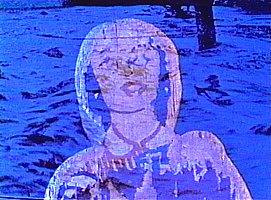 by a woman figurine, initially superimposed on a flooded landscape. Soon
we see an African-American doctor with another man and the cartoony figure
of a little girl who seems a younger version of the woman. This appears
to be some sort of domestic drama about illness — both the man and the
woman become ill, and they’re treated by the same doctor — that ends with
the woman figure surrounded by a mysterious glowing light.
by a woman figurine, initially superimposed on a flooded landscape. Soon
we see an African-American doctor with another man and the cartoony figure
of a little girl who seems a younger version of the woman. This appears
to be some sort of domestic drama about illness — both the man and the
woman become ill, and they’re treated by the same doctor — that ends with
the woman figure surrounded by a mysterious glowing light.
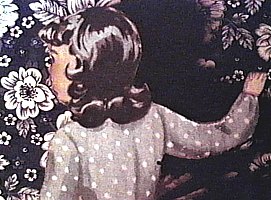
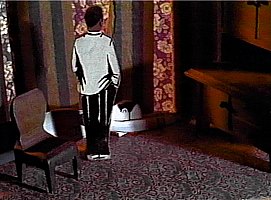
When I asked Geiser to unravel this puzzling narrative, she said that
the film was inspired by the woman figurine, given to her by a friend.
“We figured she was a wooden toy Snow White from a 1930s puzzle,” Geiser
says. “But she looked eerily like my mother, so I used her to construct
my imaginary history of my mother’s childhood.” Geiser’s mother was born
in Dubuque, and the flooded landscape refers to Mississippi River flooding;
she went to Catholic school, which explains
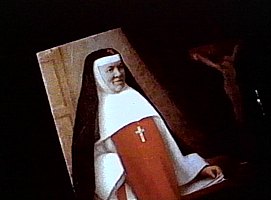 the image of a nun. Before
Geiser was born, her mother’s father became ill after a stroke, hence the
man and the doctor. In fact the film’s “secret story” is connected with
her grandfather’s illness: a mild man, after his stroke he occasionally
became violent and had to be locked in his room, a fact that was kept from
the rest of the family. Geiser describes the choice of a black doctor as
“race-blind casting” but notes that while she was making the film her father
became ill and had a dark-skinned physician of Indian descent.
the image of a nun. Before
Geiser was born, her mother’s father became ill after a stroke, hence the
man and the doctor. In fact the film’s “secret story” is connected with
her grandfather’s illness: a mild man, after his stroke he occasionally
became violent and had to be locked in his room, a fact that was kept from
the rest of the family. Geiser describes the choice of a black doctor as
“race-blind casting” but notes that while she was making the film her father
became ill and had a dark-skinned physician of Indian descent.
None of this, of course, can be divined from the film. The woman superimposed
over images of a flood is unlikely to suggest Dubuque to anyone. But the
fact that not all of Geiser’s inspirations will translate is fine with
her: “This is my own mythology — you may not know the players, but they
may be recognizable archetypes. I want it to connect more on the emotional
level.” What’s clear is that this is a family story of illness and spiritual
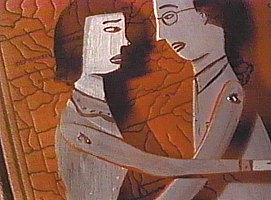
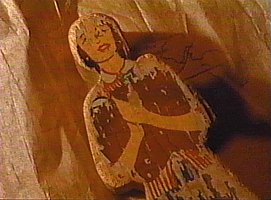 redemption. In an early sequence presumably showing the main character’s
conception and birth, a cutout man with a hinged arm touches a woman’s
thigh, a bundle descends from the couple, and its paper unwraps magically
to reveal the wooden figurine. The movement of a hinged arm initiating
procreation is characteristic of the charm of Geiser’s work: cut paper
and static figures create a world that’s both plausible and absurd.
redemption. In an early sequence presumably showing the main character’s
conception and birth, a cutout man with a hinged arm touches a woman’s
thigh, a bundle descends from the couple, and its paper unwraps magically
to reveal the wooden figurine. The movement of a hinged arm initiating
procreation is characteristic of the charm of Geiser’s work: cut paper
and static figures create a world that’s both plausible and absurd.
One always perceives Geiser’s figures and objects as creations of film
rather than filmed theater. When the mother/Snow White figure first appears
in The Secret Story, she has her back to us. Geiser then rotates
the figure to show her face, a device that’s the cinematic parallel of
a theatrical curtain raising. This little rotation within the frame sets
up the work’s whole system of object and figure movements. Early on Geiser
superimposes two dense floral patterns on a similar one, creating a fairly
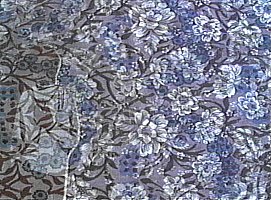 abstract moving tapestry of flowers, the doctor only barely visible in
superimposition; immediately after, when the doctor meets his male patient,
a similar pattern adorns the wallpaper. Although this connection clearly
locates the action in the past, Geiser seems as interested in the textures
the floral patterns create as she is in the linear narrative.
abstract moving tapestry of flowers, the doctor only barely visible in
superimposition; immediately after, when the doctor meets his male patient,
a similar pattern adorns the wallpaper. Although this connection clearly
locates the action in the past, Geiser seems as interested in the textures
the floral patterns create as she is in the linear narrative.
One of Geiser’s main themes is that the illusions we create in memory
or imagination are both seductive and subject to dissolution. The Secret
Story 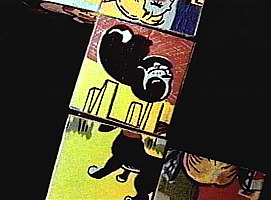 shows a grid of kids’ blocks, each with a different brightly
colored picture on it, creating a highly fragmented image; one of the blocks
rotates, and then they begin to move apart until finally only one is left.
Childhood memories are not coherent stories in Geiser’s work. The wholeness
of the past is irretrievable; as avant-garde filmmaking guru Jonas
Mekas once said in another context, all that’s left are the fragments.
The film’s “epiphany” begins when the sound track of ambient wind and water
sounds and occasional music turns into a woman’s wordless chant and the
mother figure appears in a forest illuminated by a pattern of moving light
and shadow. These images are intercut with a single shot of the blocks
under the same pattern of moving light. In a commercial film, this technique
would indicate spatial contiguity, but Geiser replaces that
shows a grid of kids’ blocks, each with a different brightly
colored picture on it, creating a highly fragmented image; one of the blocks
rotates, and then they begin to move apart until finally only one is left.
Childhood memories are not coherent stories in Geiser’s work. The wholeness
of the past is irretrievable; as avant-garde filmmaking guru Jonas
Mekas once said in another context, all that’s left are the fragments.
The film’s “epiphany” begins when the sound track of ambient wind and water
sounds and occasional music turns into a woman’s wordless chant and the
mother figure appears in a forest illuminated by a pattern of moving light
and shadow. These images are intercut with a single shot of the blocks
under the same pattern of moving light. In a commercial film, this technique
would indicate spatial contiguity, but Geiser replaces that
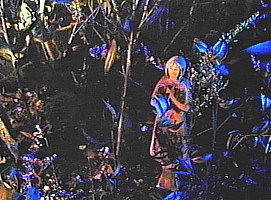 interference
with the idea of an emotional continuum that overrides geography: the moving
light not only connects childhood enchantment with her mother’s redemption
but reveals the constructed nature of both experiences.
interference
with the idea of an emotional continuum that overrides geography: the moving
light not only connects childhood enchantment with her mother’s redemption
but reveals the constructed nature of both experiences.
In general Geiser’s constructions and conflations set her figures adrift
in space and time. Frequently looking toward the past — the decor of her
films often signals prior decades — she also attempts to stop time, creating
dream worlds in which memory and fantasy 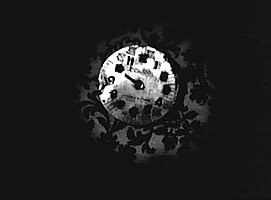 intertwine. Immer Zu and Lost
Motion both appear to begin with images of clocks (the moving hand
in Lost Motion is actually an old radio dial), going backward as
well as forward. Both films have repetitive sound tracks that don’t really
progress, helping to suspend time. In Immer Zu, it’s a collage of
music from 40s Hollywood films, and in Lost Motion, it’s a kind
of trance music by Tom
Recchion.
intertwine. Immer Zu and Lost
Motion both appear to begin with images of clocks (the moving hand
in Lost Motion is actually an old radio dial), going backward as
well as forward. Both films have repetitive sound tracks that don’t really
progress, helping to suspend time. In Immer Zu, it’s a collage of
music from 40s Hollywood films, and in Lost Motion, it’s a kind
of trance music by Tom
Recchion.
Geiser’s dream worlds include failure too: things seldom come together, and when they do, we sense their artificiality. One might look for the roots of such a vision in a troubled childhood, but Geiser says her large, relatively happy family was “not dysfunctional” and remains in close touch. She mentions instead the anxiety induced by elementary-school shelter drills in the late 50s and early 60s, which conjured up the possibility of nuclear annihilation. “There was a feeling that the end of the world could be near, the kind of destruction that had never been visited on us before.” She was afraid but also fascinated — she loved apocalyptic B-movies like The Day the Earth Stood Still.
Unlike many animators, Geiser doesn’t try to create realistic spaces even in single shots. There are depth effects to be sure, but like her editing they don’t produce a space one feels one could walk through. She acknowledges a love for Gothic art and cathedrals and the frescoes of Giotto — and calls the much later Raphael “almost too voluptuous, too finished, too grand, too trying to be real.” Avoiding realistic illusions, she leaves more space for viewers to wander and to invent their own stories. Geiser’s discontinuities suggest that cinema cannot replace physical reality; her fragmented images and narratives are seductive but don’t offer enough information to feel “finished.”
Lost Motion is the sumptuously told tale of a failed search. Inspired by the figure of a man with a coat over his arm — it “really felt like he was waiting for someone,” Geiser says — she concocted a narrative of missed connections. A letter suggests that a woman will meet the man at a Chicago train station, but when he goes there she doesn’t arrive — though her face replaces those of the passengers, presumably as he thinks about her. Eventually he winds up on the wrong side of the tracks, in a forest of industrial buildings obviously built from erector sets, including such moving pieces as a turning wheel. Seductive female figures appear, and he lies beside one; Geiser says that someone dubbed this the “erector-set brothel scene.”
In her most visually lush film to date, Geiser superimposes images and drapes her scenes in moving shadow patterns. She depicts the train’s arrival by superimposing images of dolls exiting model trains over the searching man’s figure. Using a dollhouse as a set and illuminating the windows from outside with daylight filtered through moving leaves, she creates dramatic shadows, and her thick colors in Lost Motion enhance a densely layered fabric of patterns and figures. Ultimately the film’s fragmentary constructions become more than modernist denials of illusion and assertions of materiality: essential to the film’s tone, Geiser’s obviously illusory images evoke strong feelings as the mundane drama of a failed meeting becomes intertwined with an essay on the way our lushest dreams fail by virtue of their very extravagance.
Copyright © Fred Camper 2000
 Immer Zu (1997) centers on the discovery of a punched tape whose coded, glyphlike symbols suggest that the film's images have a secret and ultimately indecipherable meaning. And Lost Motion (1999) is Geiser's most gorgeous and compelling film to date, a drama of missed connections in which figurines move through lushly colored locales, the entire frame filled with patterns like those made by moving shadows. Also on the program, The Secret Story (1996) and two works in progress; Geiser, who lives in Los Angeles, will attend the screening.
Immer Zu (1997) centers on the discovery of a punched tape whose coded, glyphlike symbols suggest that the film's images have a secret and ultimately indecipherable meaning. And Lost Motion (1999) is Geiser's most gorgeous and compelling film to date, a drama of missed connections in which figurines move through lushly colored locales, the entire frame filled with patterns like those made by moving shadows. Also on the program, The Secret Story (1996) and two works in progress; Geiser, who lives in Los Angeles, will attend the screening.
Janie Geiser's films are available for rental from the Film-Makers' Cooperative and Canyon Cinema.
Related links:
Geiser reference page
Geiser interview on The Red Book